Jul 13, 2023
The Rise of Micro-SaaS: Empowering Small Businesses in a Digital World

What is Micro-SaaS?
Have you begun your entrepreneurship journey yet? If not, you're reading about the next ample opportunity! A new player has emerged and is making waves: micro-SaaS. Combining the benefits of software-as-a-service (SaaS) with the tech stack of GenAI to solve particular user needs. They don’t try to be a horizontal platform. They're vertical knives.
If analogies are anything to go by, then think about how a Swiss knife can do a lot of things, but if a chef wants to cut bread 100 times in a day, he prefers to use a bread knife. Just like that, a productivity enhancement tool, for example, allows the user to do a specific task well and focuses on providing that particular feature.
Thus, we define Micro-SaaS as “the ability to go specific and deep for a set of users and provide actionable value (to quantifiably save time and make money and save money) using a technology product.”
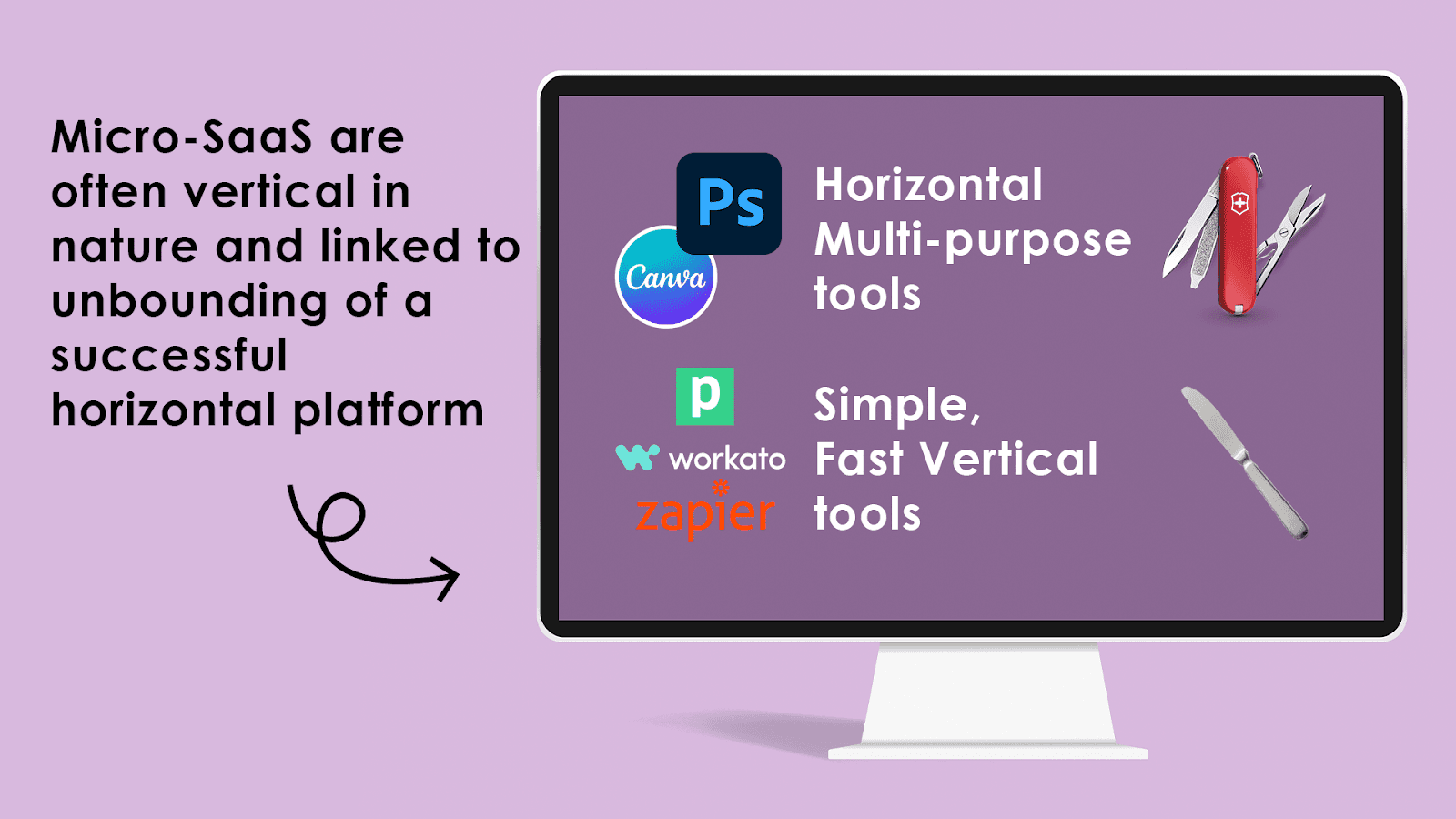
How is Micro SaaS different from SaaS?
In the realm of software-as-a-service (SaaS), Micro-SaaS has generated quite a buzz.
But what exactly sets Micro-SaaS apart from the conventional SaaS we've come to know and love?
Picture it like this - if SaaS is a gigantic shopping mall housing many stores, Micro-SaaS is like a small boutique that caters to a very niche market. In essence, while traditional SaaS tackles large-scale problems with extensive solutions, Micro-SaaS targets user-specific pain points with a laser-like focus.
If you're an entrepreneur, Micro-SaaS empower individuals like you, who possess valuable expertise and insights in a particular domain, to create and deliver solutions tailored to a targeted niche audience. Gone are the days of feeling like a tiny fish in the vast SaaS ocean - Micro-SaaS allows you to swim in your pond, where you can truly make a splash.
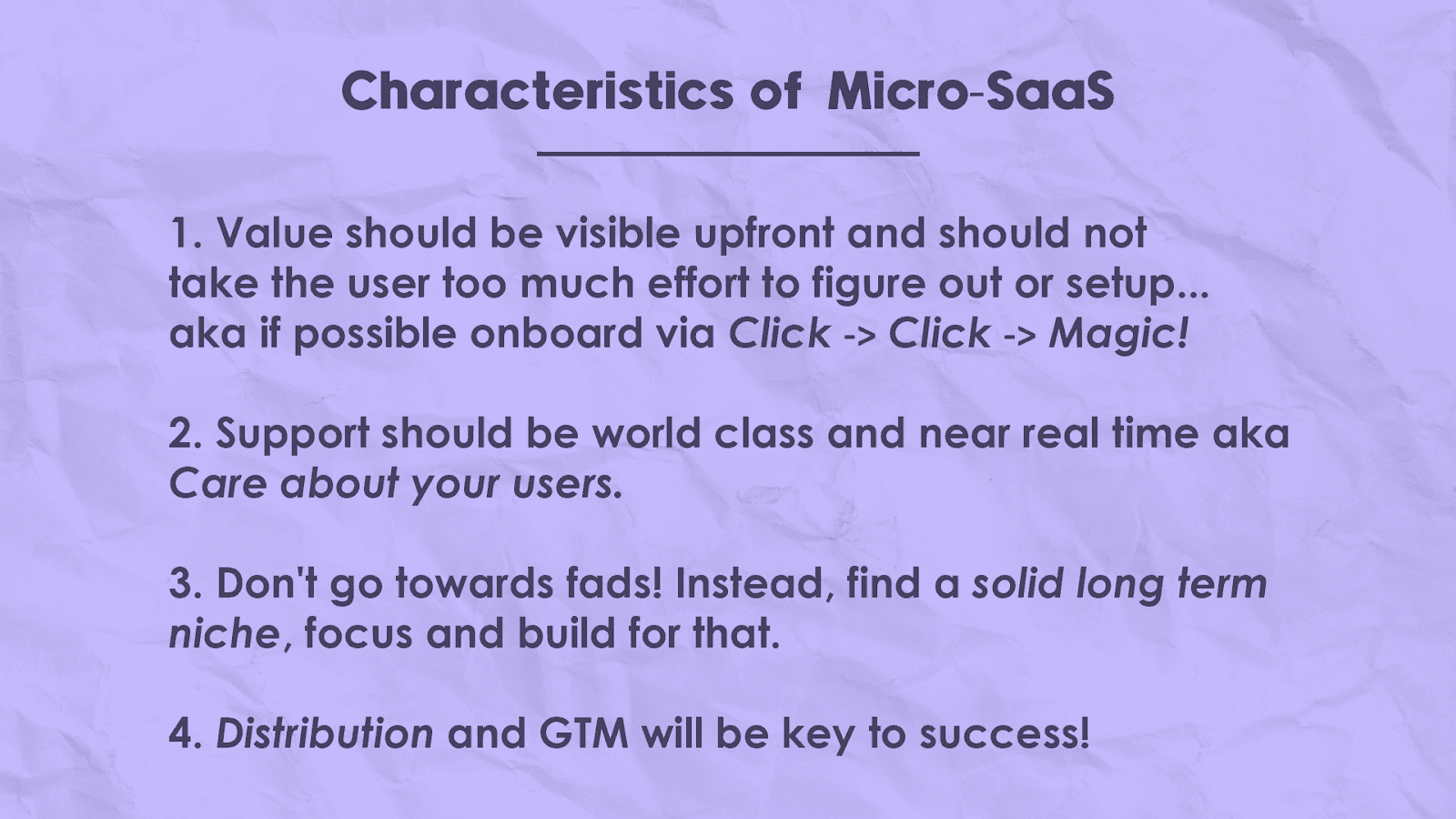
People often make the mistake of assuming why would an application performing specific features replace the more advanced extensive ones.
Have you ever felt frustrated by the lack of tailored solutions for your needs? Now imagine how many others out there are feeling the same way. That's your golden ticket! As an entrepreneur, identifying and empathizing with the pain points of your niche audience is your superpower, and Micro-SaaS gives you the means to address specific problems specifically.
So, whether you're a solopreneur or a small team, the opportunities are ripe for the picking. Remember, the secret to thriving in this fast-paced digital world is finding the right balance between specialization and scalability. Micro-SaaS lets you do just that - catering to a niche market while building a sustainable business.
Advantages and Opportunities for Entrepreneurs and future builders in Micro-SaaS
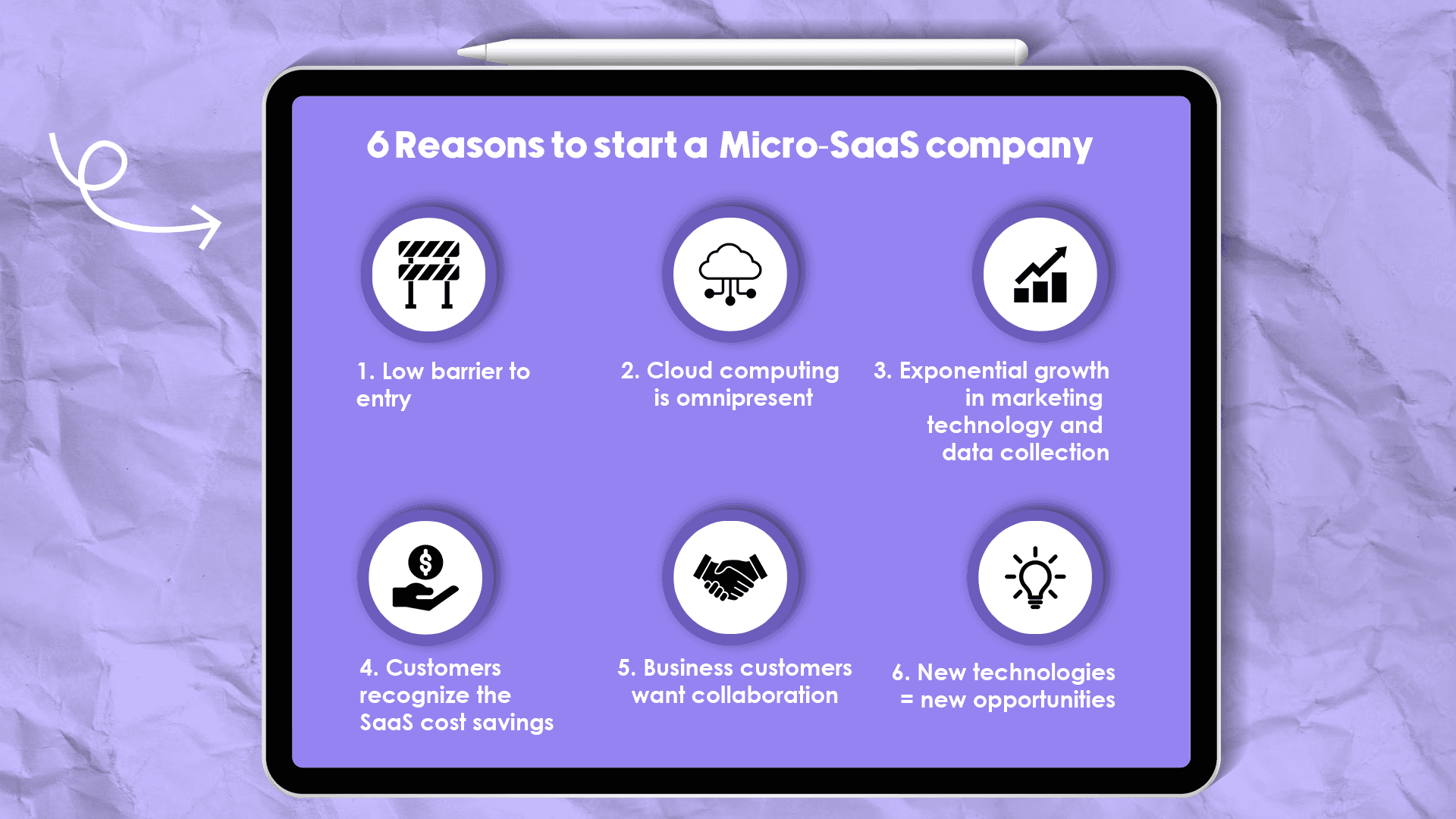
Targeted Niche Markets: Unlocking the Power of Specialization
Specialization is the cornerstone of Micro-SaaS success. Armed with practical strategies, these agile businesses tap into niche markets and deliver highly relevant software solutions that address their customers' exact needs. By crafting tailor-made solutions that cater to unique pain points, Micro-SaaS businesses gain a competitive edge, setting them apart from their generic competitors.
A SaaS product, Zapier, became a widely successful platform with a vast user base.
But, over time, it has also built many integrations (1000+) to expand its TAM and user needs. While it has become a powerful tool, it has most likely alienated users who need a simple “click, click …. Magic”. This scenario has sparked the rise of industry-specific tools like work to and alloys gaining popularity. These solutions cater precisely to vertical user needs without compromising user experience.
The benefits of Micro-SaaS specialization are far-reaching. With a clear and intuitive user interface accompanied by streamlined workflows, businesses witness a lower learning curve. As a result, user acquisition costs decrease, making it a more cost-effective route for the entrepreneur and the customer.
Flexibility and Scalability: Empowering Entrepreneurs to Grow at Their Own Pace

Flexibility and scalability are two characteristics that distinguish micro-SaaS as a powerful tool for entrepreneurs seeking gradual yet sustainable growth. The inherent nature of micro-SaaS allows business owners to begin with modest offerings and then scale up progressively in response to the expanding customer base. This feature grants entrepreneurs the freedom to align with the ever-changing market demands.
Whether you're a one-person army or a small dedicated team, micro-SaaS caters to your needs. As your Micro-SaaS venture gains traction, you can expand your product or service offerings numerically, ensuring you maintain a perfect balance between innovation and customer satisfaction.
So, if you envision a future where your business thrives at its own pace, you're most likely thinking about micro-SaaS. The freedom to evolve, serve your customers better, and build a strong foundation for a successful, scalable venture is what every entrepreneur dreams of. Because with flexibility and scalability at your disposal, the sky's the limit for your entrepreneurial aspirations.
Lower Costs and Reduced Barriers to Entry: Making Entrepreneurship Accessible

Are you waiting to raise enough startup capital? Micro-SaaS brings a wave of accessibility and opportunity by substantially reducing costs and eliminating daunting barriers to entry. Unlike SaaS, micro-SaaS ventures can be initiated with minimal resources.
The reduced financial costs allow ambitious individuals to step into and analyze the software market confidently without facing heavy upfront investments.
Not just limited to cost savings, the journey of micro-SaaS entrepreneurship instills a culture of resourcefulness and efficiency. As founders navigate the challenges of limited resources, they learn to make informed decisions that lay a strong foundation for long-term success.
Moreover, the adaptability of micro-SaaS empowers entrepreneurs to embrace innovation and refine strategies. This agile approach ensures that even small teams or solopreneurs can compete on an equal footing with established players in the market.
Hybrid Revenue Models: Ensuring Long-Term Sustainability

Image Source: Click Here
As businesses grow into large platforms, the pressure to maintain growth and find effective monetization strategies becomes paramount. However, Micro-SaaS ventures built on frugal discipline and genuine Product-Market Fit (PMF) have room for experimentation. This unique positioning enables them to try out various monetization options that cater precisely to the needs of their micro-segment tools.
One notable approach gaining popularity is the adoption of hybrid revenue models. These models strike a balance between different monetization methods. These ensure both the long-term sustainability of the business and customer satisfaction. Responding to customer feedback regarding SaaS subscription fatigue, some Micro-SaaS platforms have embraced freemium and pay-as-you-go (PAYG) models.
Freemium models offer basic features of the tool for free, calling users to explore the platform's value before committing to premium features. On the other hand, PAYG models empower customers to pay only for the specific services they utilize, promoting transparency and cost-effectiveness.
In Micro-SaaS, it's not just about finding a single revenue approach but embracing hybridization's power. Can these ventures continue to thrive on frugality, genuine PMF, and customer-centricity?
Yes, because the journey toward sustainable success is paved with innovative monetization possibilities. Through their holistic approach, Micro-SaaS ventures aim at long-term viability and customer delight.
The Micro-SaaS Ecosystem and Growth Opportunities
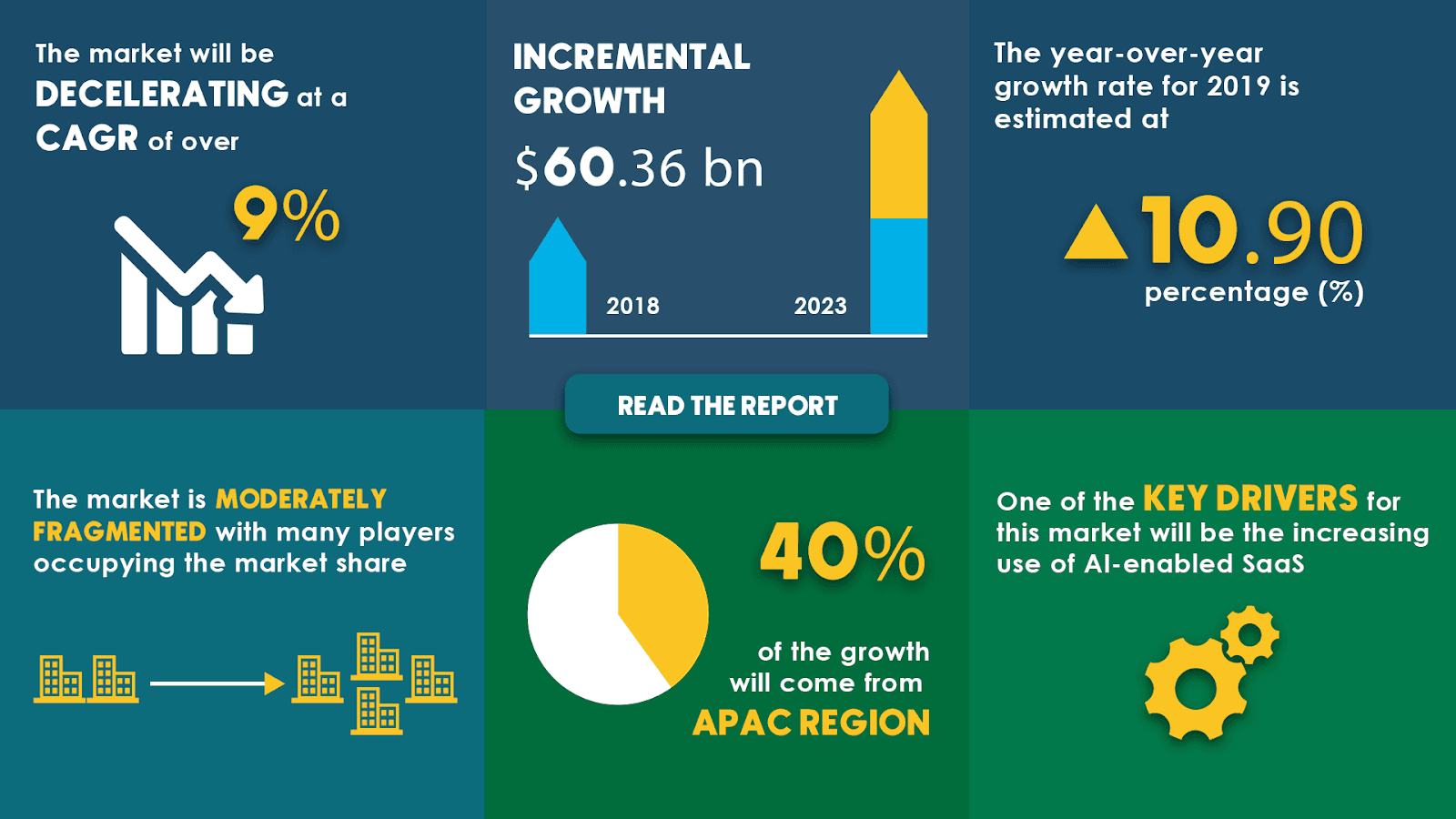
As the concept of micro-SaaS gains momentum, a whole ecosystem is emerging to support and nurture these niche-focused ventures. This ecosystem encompasses a range of players, including developers, marketers, investors, and even customers.
Developer Communities and Tools

Image Source: Click Here
The rise of micro-SaaS has led to the emergence of dedicated developer communities focused on building specialized tools and products. These communities act as innovation hubs, allowing developers to collaborate, share insights, and build upon each other's ideas. With the support of these communities, developers can create robust solutions that cater precisely to the needs of their niche audience.
Additionally, various low-code and no-code platforms have surfaced, enabling entrepreneurs with limited technical expertise to create micro-SaaS products. These platforms offer pre-built components and drag-and-drop interfaces, making it easier for non-technical founders to turn their ideas into reality.
Marketing Channels and Influencers
While traditional SaaS businesses often rely on broad marketing campaigns, micro-SaaS ventures leverage targeted marketing strategies to reach their niche audience effectively. Micro-influencers, who possess a dedicated following within a specific domain, have become instrumental in promoting micro-SaaS products to their engaged communities. Collaborating with relevant influencers allows these businesses to gain exposure and build credibility within their target markets.
Furthermore, niche-focused marketing channels and forums offer fertile ground for micro-SaaS businesses to engage with potential customers directly. By participating in discussions and offering valuable insights, entrepreneurs can position themselves as industry experts, increasing brand visibility and trust.
Micro-SaaS Investment Landscape
The success and potential of micro-SaaS businesses has not gone unnoticed by investors. Venture capitalists and angel investors seek out these focused ventures with promising growth prospects. The relatively lower upfront investment required by micro-SaaS businesses makes them an attractive option for investors looking to diversify their portfolios.
Micro-SaaS entrepreneurs can benefit from this growing interest by tapping into these funding opportunities. Securing early-stage investments allows businesses to accelerate product development, scale marketing efforts, and feed customer acquisition initiatives.
Customer-Centric Feedback Loops

Image Source: Click Here
Customer feedback is the lifeblood of any successful business, and micro-SaaS ventures are no exception. These businesses have the unique advantage of establishing more direct and intimate customer relationships. As a result, they can gather valuable insights and understand their users' pain points in great detail.
By actively engaging with customers, micro-SaaS entrepreneurs can iterate on their products rapidly and implement updates that directly address user needs. This continuous feedback loop helps businesses refine their offerings and stay ahead of the competition.
Successful Examples of Micro-SaaS Businesses: "Companies that started as Micro-SaaS but have grown."
Case Study 1: Unleashing the Power of Automation for Small Businesses
Company: Zapier
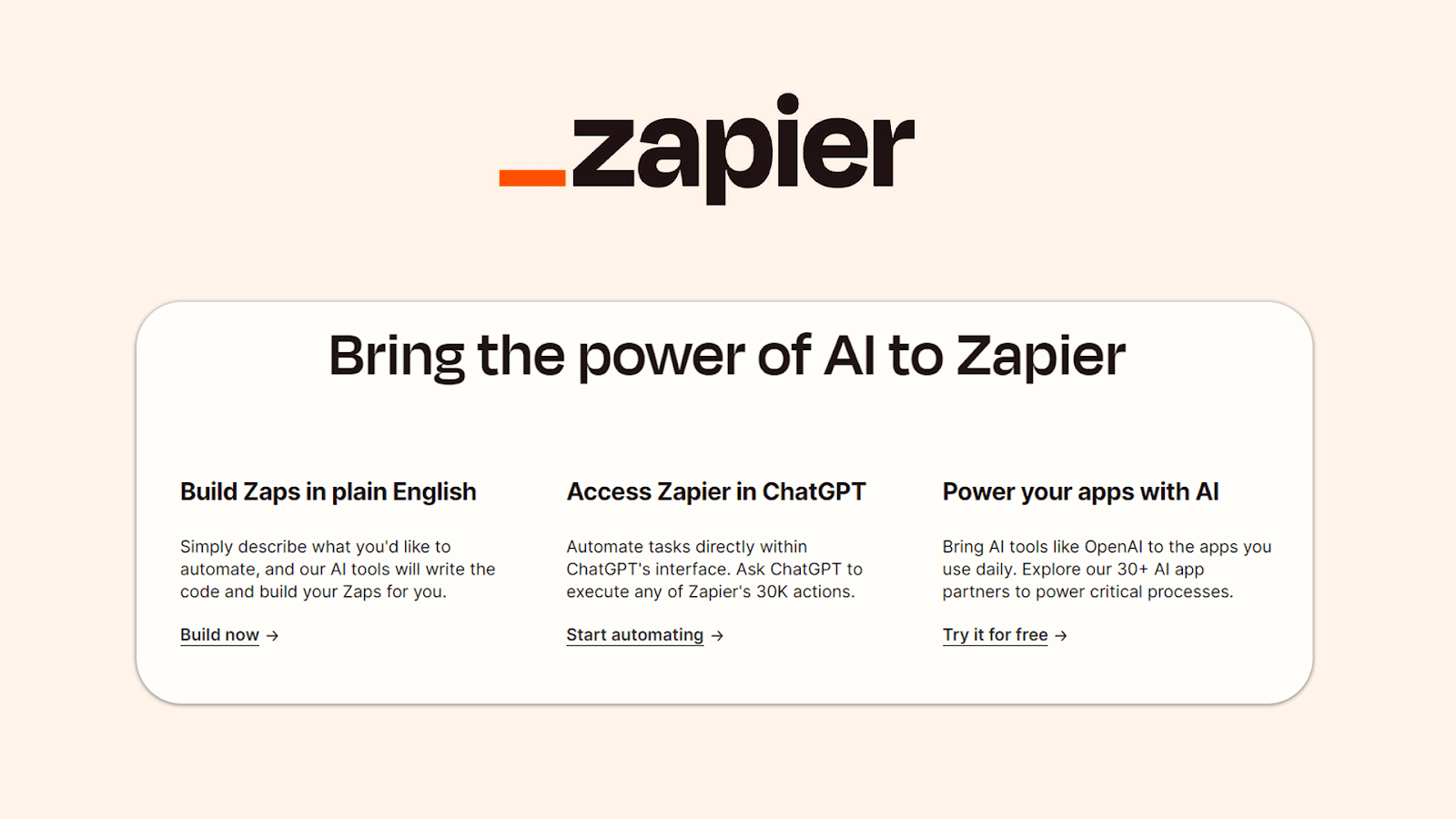
Problem: Small businesses often find themselves burdened with a multitude of manual tasks, which not only consume valuable time but also hinder overall efficiency.
Solution: Zapier, conceived initially as a micro-SaaS venture, emerged as a transformative solution by offering a powerful platform for task automation between various apps and services. This innovative approach empowers small businesses to streamline their workflows, liberating time and resources to concentrate on more critical aspects of their operations.
Scaling: The success of Zapier as a micro-SaaS business can be attributed to its strategic focus on a niche market and the unwavering commitment to deliver a top-notch product. By honing in on a specific customer segment, Zapier has tailored its services to meet their needs, fostering loyalty and trust within the target audience. Boasting an impressive user base, Zapier is indeed redefining the Micro-SaaS landscape.
Case Study 2: Typeform: Revolutionizing Data Collection with Engaging Forms
Company: Typeform

Problem: Businesses often encounter challenges when collecting customer information, as traditional forms can be dull and time-consuming, leading to lower response rates.
Solution: Typeform, a dynamic micro-SaaS business, offers an interactive form platform. Their visually appealing and engaging forms engage respondents, resulting in higher completion rates and more valuable data for companies to analyze.
Scaling: With a keen understanding of its audience's needs, Typeform has crafted a customer-centric experience that fosters loyalty and satisfaction. The company boasts an impressive user base, solidifying its position as a prominent micro-SaaS business worldwide.
Case Study 3: Intercom: Enhancing Customer Communication for Business Success
Company: Intercom

Problem: Effective customer communication is a pivotal challenge for businesses, impacting customer churn, sales, and overall experience.
Solution: Intercom, a micro-SaaS business offering a comprehensive customer communication platform. Through email, chat, and push notifications, Intercom empowers businesses to foster strong customer relationships while providing essential support.
Scaling: By catering to a specific market segment, Intercom tailors its product to meet customer needs, earning trust and loyalty precisely. Today, with 30,000+ satisfied customers, Intercom stands tall as a leader.
Common Customer Acquisition Techniques
Zapier, Typeform, and Intercom, three exemplary micro-SaaS businesses, have adopted effective customer acquisition techniques to fuel their success. These companies rely on content marketing, strategic partnerships, and word-of-mouth referrals to build their customer base.
Content Marketing: One of the primary channels for customer acquisition is content marketing. Zapier, Typeform, and Intercom actively publish blog posts, e-books, and other valuable content that educates businesses about the significance of their services. By offering insights, tips, and industry expertise, they establish themselves as thought leaders, drawing potential customers into their ecosystem.
Partnerships: These niche-market software solutions recognize the power of collaboration. Zapier, Typeform, and Intercom form strategic alliances with other companies to create joint solutions that cater to their customers' diverse needs. These partnerships not only expand their product offerings but also enable access to new customer segments.
Word-of-Mouth: Satisfied customers become advocates, leading to organic growth through word-of-mouth referrals. The exceptional value provided by Zapier, Typeform, and Intercom prompts customers to share their positive experiences with friends and colleagues, fostering trust and credibility in the market.
These micro-SaaS businesses have achieved remarkable success by addressing specific pain points in their target markets and delivering high-quality products. Their focus on niche markets and customer-centric approaches have paved the way for scaling their businesses and attaining global recognition.
In conclusion, Zapier, Typeform, and Intercom exemplify how micro-SaaS ventures can thrive through strategic customer acquisition techniques. As people continue to seek tailored solutions, these success stories inspire entrepreneurs to embark on their micro-SaaS journeys, armed with valuable insights on customer acquisition and product excellence.
Conclusion
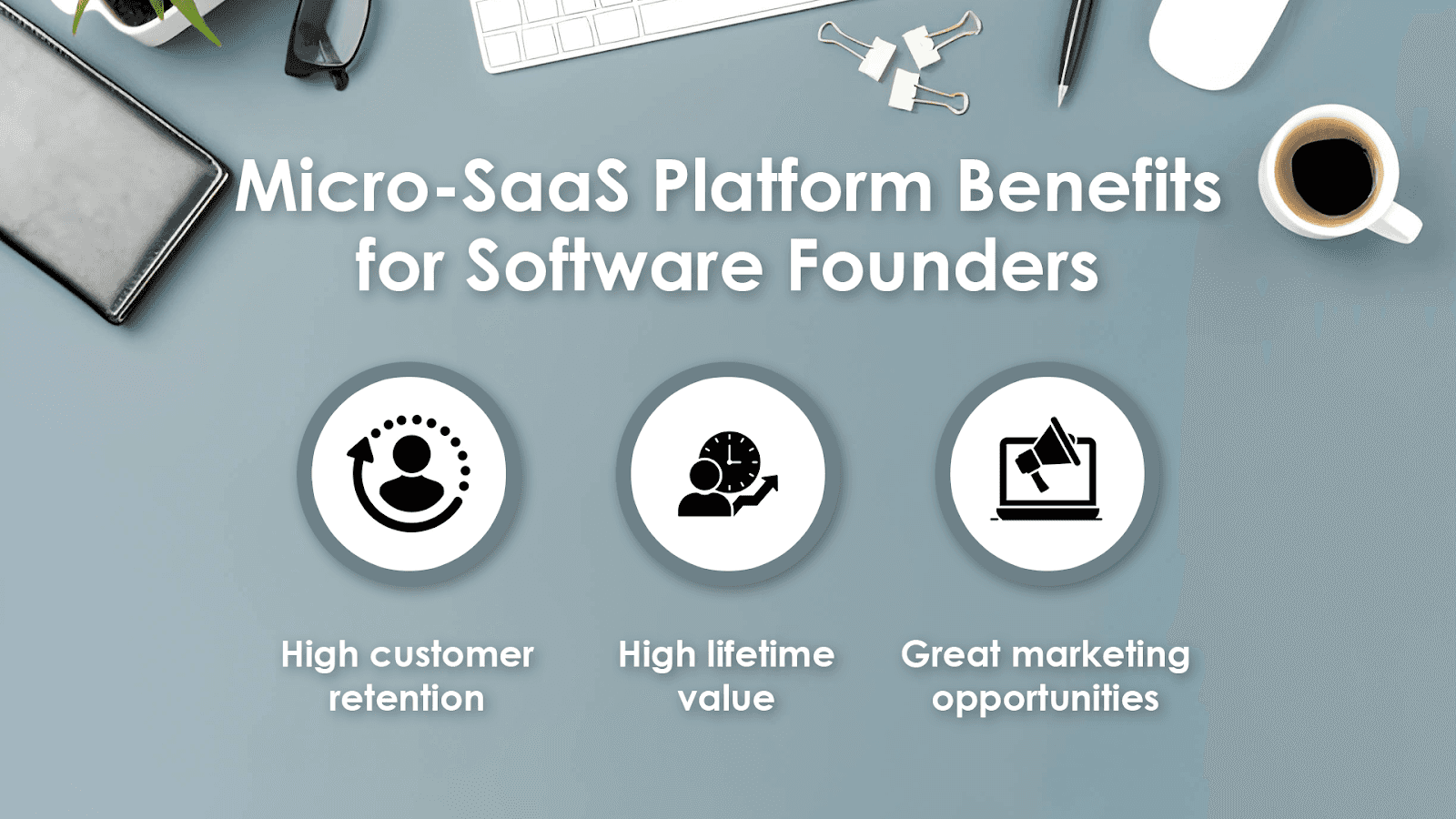
Embrace the Micro-SaaS Revolution: Drive Innovation and Deliver Value
Micro-SaaS is the driving force behind a new era of how business is done, providing small businesses with the tools they need to succeed within a rapidly evolving digital landscape. By embracing the flexibility, scalability, and targeted nature of micro-SaaS, entrepreneurs can make a lasting impact on their industries.
Moreover, the beauty of micro-SaaS lies in its accessibility. With reduced barriers to entry and lower costs compared to traditional software development, entrepreneurs can bring their ideas to life without breaking the bank.
As the micro-SaaS landscape continues to evolve, there is ample opportunity for ambitious entrepreneurs to shape the future. By embracing the unique advantages of micro-SaaS, they can thrive in the digital era, driving innovation and shaping the end of the industries they establish themselves in.
Jul 13, 2023
The Rise of Micro-SaaS: Empowering Small Businesses in a Digital World

What is Micro-SaaS?
Have you begun your entrepreneurship journey yet? If not, you're reading about the next ample opportunity! A new player has emerged and is making waves: micro-SaaS. Combining the benefits of software-as-a-service (SaaS) with the tech stack of GenAI to solve particular user needs. They don’t try to be a horizontal platform. They're vertical knives.
If analogies are anything to go by, then think about how a Swiss knife can do a lot of things, but if a chef wants to cut bread 100 times in a day, he prefers to use a bread knife. Just like that, a productivity enhancement tool, for example, allows the user to do a specific task well and focuses on providing that particular feature.
Thus, we define Micro-SaaS as “the ability to go specific and deep for a set of users and provide actionable value (to quantifiably save time and make money and save money) using a technology product.”

How is Micro SaaS different from SaaS?
In the realm of software-as-a-service (SaaS), Micro-SaaS has generated quite a buzz.
But what exactly sets Micro-SaaS apart from the conventional SaaS we've come to know and love?
Picture it like this - if SaaS is a gigantic shopping mall housing many stores, Micro-SaaS is like a small boutique that caters to a very niche market. In essence, while traditional SaaS tackles large-scale problems with extensive solutions, Micro-SaaS targets user-specific pain points with a laser-like focus.
If you're an entrepreneur, Micro-SaaS empower individuals like you, who possess valuable expertise and insights in a particular domain, to create and deliver solutions tailored to a targeted niche audience. Gone are the days of feeling like a tiny fish in the vast SaaS ocean - Micro-SaaS allows you to swim in your pond, where you can truly make a splash.

People often make the mistake of assuming why would an application performing specific features replace the more advanced extensive ones.
Have you ever felt frustrated by the lack of tailored solutions for your needs? Now imagine how many others out there are feeling the same way. That's your golden ticket! As an entrepreneur, identifying and empathizing with the pain points of your niche audience is your superpower, and Micro-SaaS gives you the means to address specific problems specifically.
So, whether you're a solopreneur or a small team, the opportunities are ripe for the picking. Remember, the secret to thriving in this fast-paced digital world is finding the right balance between specialization and scalability. Micro-SaaS lets you do just that - catering to a niche market while building a sustainable business.
Advantages and Opportunities for Entrepreneurs and future builders in Micro-SaaS

Targeted Niche Markets: Unlocking the Power of Specialization
Specialization is the cornerstone of Micro-SaaS success. Armed with practical strategies, these agile businesses tap into niche markets and deliver highly relevant software solutions that address their customers' exact needs. By crafting tailor-made solutions that cater to unique pain points, Micro-SaaS businesses gain a competitive edge, setting them apart from their generic competitors.
A SaaS product, Zapier, became a widely successful platform with a vast user base.
But, over time, it has also built many integrations (1000+) to expand its TAM and user needs. While it has become a powerful tool, it has most likely alienated users who need a simple “click, click …. Magic”. This scenario has sparked the rise of industry-specific tools like work to and alloys gaining popularity. These solutions cater precisely to vertical user needs without compromising user experience.
The benefits of Micro-SaaS specialization are far-reaching. With a clear and intuitive user interface accompanied by streamlined workflows, businesses witness a lower learning curve. As a result, user acquisition costs decrease, making it a more cost-effective route for the entrepreneur and the customer.
Flexibility and Scalability: Empowering Entrepreneurs to Grow at Their Own Pace

Flexibility and scalability are two characteristics that distinguish micro-SaaS as a powerful tool for entrepreneurs seeking gradual yet sustainable growth. The inherent nature of micro-SaaS allows business owners to begin with modest offerings and then scale up progressively in response to the expanding customer base. This feature grants entrepreneurs the freedom to align with the ever-changing market demands.
Whether you're a one-person army or a small dedicated team, micro-SaaS caters to your needs. As your Micro-SaaS venture gains traction, you can expand your product or service offerings numerically, ensuring you maintain a perfect balance between innovation and customer satisfaction.
So, if you envision a future where your business thrives at its own pace, you're most likely thinking about micro-SaaS. The freedom to evolve, serve your customers better, and build a strong foundation for a successful, scalable venture is what every entrepreneur dreams of. Because with flexibility and scalability at your disposal, the sky's the limit for your entrepreneurial aspirations.
Lower Costs and Reduced Barriers to Entry: Making Entrepreneurship Accessible

Are you waiting to raise enough startup capital? Micro-SaaS brings a wave of accessibility and opportunity by substantially reducing costs and eliminating daunting barriers to entry. Unlike SaaS, micro-SaaS ventures can be initiated with minimal resources.
The reduced financial costs allow ambitious individuals to step into and analyze the software market confidently without facing heavy upfront investments.
Not just limited to cost savings, the journey of micro-SaaS entrepreneurship instills a culture of resourcefulness and efficiency. As founders navigate the challenges of limited resources, they learn to make informed decisions that lay a strong foundation for long-term success.
Moreover, the adaptability of micro-SaaS empowers entrepreneurs to embrace innovation and refine strategies. This agile approach ensures that even small teams or solopreneurs can compete on an equal footing with established players in the market.
Hybrid Revenue Models: Ensuring Long-Term Sustainability

Image Source: Click Here
As businesses grow into large platforms, the pressure to maintain growth and find effective monetization strategies becomes paramount. However, Micro-SaaS ventures built on frugal discipline and genuine Product-Market Fit (PMF) have room for experimentation. This unique positioning enables them to try out various monetization options that cater precisely to the needs of their micro-segment tools.
One notable approach gaining popularity is the adoption of hybrid revenue models. These models strike a balance between different monetization methods. These ensure both the long-term sustainability of the business and customer satisfaction. Responding to customer feedback regarding SaaS subscription fatigue, some Micro-SaaS platforms have embraced freemium and pay-as-you-go (PAYG) models.
Freemium models offer basic features of the tool for free, calling users to explore the platform's value before committing to premium features. On the other hand, PAYG models empower customers to pay only for the specific services they utilize, promoting transparency and cost-effectiveness.
In Micro-SaaS, it's not just about finding a single revenue approach but embracing hybridization's power. Can these ventures continue to thrive on frugality, genuine PMF, and customer-centricity?
Yes, because the journey toward sustainable success is paved with innovative monetization possibilities. Through their holistic approach, Micro-SaaS ventures aim at long-term viability and customer delight.
The Micro-SaaS Ecosystem and Growth Opportunities

As the concept of micro-SaaS gains momentum, a whole ecosystem is emerging to support and nurture these niche-focused ventures. This ecosystem encompasses a range of players, including developers, marketers, investors, and even customers.
Developer Communities and Tools

Image Source: Click Here
The rise of micro-SaaS has led to the emergence of dedicated developer communities focused on building specialized tools and products. These communities act as innovation hubs, allowing developers to collaborate, share insights, and build upon each other's ideas. With the support of these communities, developers can create robust solutions that cater precisely to the needs of their niche audience.
Additionally, various low-code and no-code platforms have surfaced, enabling entrepreneurs with limited technical expertise to create micro-SaaS products. These platforms offer pre-built components and drag-and-drop interfaces, making it easier for non-technical founders to turn their ideas into reality.
Marketing Channels and Influencers
While traditional SaaS businesses often rely on broad marketing campaigns, micro-SaaS ventures leverage targeted marketing strategies to reach their niche audience effectively. Micro-influencers, who possess a dedicated following within a specific domain, have become instrumental in promoting micro-SaaS products to their engaged communities. Collaborating with relevant influencers allows these businesses to gain exposure and build credibility within their target markets.
Furthermore, niche-focused marketing channels and forums offer fertile ground for micro-SaaS businesses to engage with potential customers directly. By participating in discussions and offering valuable insights, entrepreneurs can position themselves as industry experts, increasing brand visibility and trust.
Micro-SaaS Investment Landscape
The success and potential of micro-SaaS businesses has not gone unnoticed by investors. Venture capitalists and angel investors seek out these focused ventures with promising growth prospects. The relatively lower upfront investment required by micro-SaaS businesses makes them an attractive option for investors looking to diversify their portfolios.
Micro-SaaS entrepreneurs can benefit from this growing interest by tapping into these funding opportunities. Securing early-stage investments allows businesses to accelerate product development, scale marketing efforts, and feed customer acquisition initiatives.
Customer-Centric Feedback Loops

Image Source: Click Here
Customer feedback is the lifeblood of any successful business, and micro-SaaS ventures are no exception. These businesses have the unique advantage of establishing more direct and intimate customer relationships. As a result, they can gather valuable insights and understand their users' pain points in great detail.
By actively engaging with customers, micro-SaaS entrepreneurs can iterate on their products rapidly and implement updates that directly address user needs. This continuous feedback loop helps businesses refine their offerings and stay ahead of the competition.
Successful Examples of Micro-SaaS Businesses: "Companies that started as Micro-SaaS but have grown."
Case Study 1: Unleashing the Power of Automation for Small Businesses
Company: Zapier

Problem: Small businesses often find themselves burdened with a multitude of manual tasks, which not only consume valuable time but also hinder overall efficiency.
Solution: Zapier, conceived initially as a micro-SaaS venture, emerged as a transformative solution by offering a powerful platform for task automation between various apps and services. This innovative approach empowers small businesses to streamline their workflows, liberating time and resources to concentrate on more critical aspects of their operations.
Scaling: The success of Zapier as a micro-SaaS business can be attributed to its strategic focus on a niche market and the unwavering commitment to deliver a top-notch product. By honing in on a specific customer segment, Zapier has tailored its services to meet their needs, fostering loyalty and trust within the target audience. Boasting an impressive user base, Zapier is indeed redefining the Micro-SaaS landscape.
Case Study 2: Typeform: Revolutionizing Data Collection with Engaging Forms
Company: Typeform

Problem: Businesses often encounter challenges when collecting customer information, as traditional forms can be dull and time-consuming, leading to lower response rates.
Solution: Typeform, a dynamic micro-SaaS business, offers an interactive form platform. Their visually appealing and engaging forms engage respondents, resulting in higher completion rates and more valuable data for companies to analyze.
Scaling: With a keen understanding of its audience's needs, Typeform has crafted a customer-centric experience that fosters loyalty and satisfaction. The company boasts an impressive user base, solidifying its position as a prominent micro-SaaS business worldwide.
Case Study 3: Intercom: Enhancing Customer Communication for Business Success
Company: Intercom

Problem: Effective customer communication is a pivotal challenge for businesses, impacting customer churn, sales, and overall experience.
Solution: Intercom, a micro-SaaS business offering a comprehensive customer communication platform. Through email, chat, and push notifications, Intercom empowers businesses to foster strong customer relationships while providing essential support.
Scaling: By catering to a specific market segment, Intercom tailors its product to meet customer needs, earning trust and loyalty precisely. Today, with 30,000+ satisfied customers, Intercom stands tall as a leader.
Common Customer Acquisition Techniques
Zapier, Typeform, and Intercom, three exemplary micro-SaaS businesses, have adopted effective customer acquisition techniques to fuel their success. These companies rely on content marketing, strategic partnerships, and word-of-mouth referrals to build their customer base.
Content Marketing: One of the primary channels for customer acquisition is content marketing. Zapier, Typeform, and Intercom actively publish blog posts, e-books, and other valuable content that educates businesses about the significance of their services. By offering insights, tips, and industry expertise, they establish themselves as thought leaders, drawing potential customers into their ecosystem.
Partnerships: These niche-market software solutions recognize the power of collaboration. Zapier, Typeform, and Intercom form strategic alliances with other companies to create joint solutions that cater to their customers' diverse needs. These partnerships not only expand their product offerings but also enable access to new customer segments.
Word-of-Mouth: Satisfied customers become advocates, leading to organic growth through word-of-mouth referrals. The exceptional value provided by Zapier, Typeform, and Intercom prompts customers to share their positive experiences with friends and colleagues, fostering trust and credibility in the market.
These micro-SaaS businesses have achieved remarkable success by addressing specific pain points in their target markets and delivering high-quality products. Their focus on niche markets and customer-centric approaches have paved the way for scaling their businesses and attaining global recognition.
In conclusion, Zapier, Typeform, and Intercom exemplify how micro-SaaS ventures can thrive through strategic customer acquisition techniques. As people continue to seek tailored solutions, these success stories inspire entrepreneurs to embark on their micro-SaaS journeys, armed with valuable insights on customer acquisition and product excellence.
Conclusion

Embrace the Micro-SaaS Revolution: Drive Innovation and Deliver Value
Micro-SaaS is the driving force behind a new era of how business is done, providing small businesses with the tools they need to succeed within a rapidly evolving digital landscape. By embracing the flexibility, scalability, and targeted nature of micro-SaaS, entrepreneurs can make a lasting impact on their industries.
Moreover, the beauty of micro-SaaS lies in its accessibility. With reduced barriers to entry and lower costs compared to traditional software development, entrepreneurs can bring their ideas to life without breaking the bank.
As the micro-SaaS landscape continues to evolve, there is ample opportunity for ambitious entrepreneurs to shape the future. By embracing the unique advantages of micro-SaaS, they can thrive in the digital era, driving innovation and shaping the end of the industries they establish themselves in.
Jul 13, 2023
The Rise of Micro-SaaS: Empowering Small Businesses in a Digital World

What is Micro-SaaS?
Have you begun your entrepreneurship journey yet? If not, you're reading about the next ample opportunity! A new player has emerged and is making waves: micro-SaaS. Combining the benefits of software-as-a-service (SaaS) with the tech stack of GenAI to solve particular user needs. They don’t try to be a horizontal platform. They're vertical knives.
If analogies are anything to go by, then think about how a Swiss knife can do a lot of things, but if a chef wants to cut bread 100 times in a day, he prefers to use a bread knife. Just like that, a productivity enhancement tool, for example, allows the user to do a specific task well and focuses on providing that particular feature.
Thus, we define Micro-SaaS as “the ability to go specific and deep for a set of users and provide actionable value (to quantifiably save time and make money and save money) using a technology product.”

How is Micro SaaS different from SaaS?
In the realm of software-as-a-service (SaaS), Micro-SaaS has generated quite a buzz.
But what exactly sets Micro-SaaS apart from the conventional SaaS we've come to know and love?
Picture it like this - if SaaS is a gigantic shopping mall housing many stores, Micro-SaaS is like a small boutique that caters to a very niche market. In essence, while traditional SaaS tackles large-scale problems with extensive solutions, Micro-SaaS targets user-specific pain points with a laser-like focus.
If you're an entrepreneur, Micro-SaaS empower individuals like you, who possess valuable expertise and insights in a particular domain, to create and deliver solutions tailored to a targeted niche audience. Gone are the days of feeling like a tiny fish in the vast SaaS ocean - Micro-SaaS allows you to swim in your pond, where you can truly make a splash.

People often make the mistake of assuming why would an application performing specific features replace the more advanced extensive ones.
Have you ever felt frustrated by the lack of tailored solutions for your needs? Now imagine how many others out there are feeling the same way. That's your golden ticket! As an entrepreneur, identifying and empathizing with the pain points of your niche audience is your superpower, and Micro-SaaS gives you the means to address specific problems specifically.
So, whether you're a solopreneur or a small team, the opportunities are ripe for the picking. Remember, the secret to thriving in this fast-paced digital world is finding the right balance between specialization and scalability. Micro-SaaS lets you do just that - catering to a niche market while building a sustainable business.
Advantages and Opportunities for Entrepreneurs and future builders in Micro-SaaS

Targeted Niche Markets: Unlocking the Power of Specialization
Specialization is the cornerstone of Micro-SaaS success. Armed with practical strategies, these agile businesses tap into niche markets and deliver highly relevant software solutions that address their customers' exact needs. By crafting tailor-made solutions that cater to unique pain points, Micro-SaaS businesses gain a competitive edge, setting them apart from their generic competitors.
A SaaS product, Zapier, became a widely successful platform with a vast user base.
But, over time, it has also built many integrations (1000+) to expand its TAM and user needs. While it has become a powerful tool, it has most likely alienated users who need a simple “click, click …. Magic”. This scenario has sparked the rise of industry-specific tools like work to and alloys gaining popularity. These solutions cater precisely to vertical user needs without compromising user experience.
The benefits of Micro-SaaS specialization are far-reaching. With a clear and intuitive user interface accompanied by streamlined workflows, businesses witness a lower learning curve. As a result, user acquisition costs decrease, making it a more cost-effective route for the entrepreneur and the customer.
Flexibility and Scalability: Empowering Entrepreneurs to Grow at Their Own Pace

Flexibility and scalability are two characteristics that distinguish micro-SaaS as a powerful tool for entrepreneurs seeking gradual yet sustainable growth. The inherent nature of micro-SaaS allows business owners to begin with modest offerings and then scale up progressively in response to the expanding customer base. This feature grants entrepreneurs the freedom to align with the ever-changing market demands.
Whether you're a one-person army or a small dedicated team, micro-SaaS caters to your needs. As your Micro-SaaS venture gains traction, you can expand your product or service offerings numerically, ensuring you maintain a perfect balance between innovation and customer satisfaction.
So, if you envision a future where your business thrives at its own pace, you're most likely thinking about micro-SaaS. The freedom to evolve, serve your customers better, and build a strong foundation for a successful, scalable venture is what every entrepreneur dreams of. Because with flexibility and scalability at your disposal, the sky's the limit for your entrepreneurial aspirations.
Lower Costs and Reduced Barriers to Entry: Making Entrepreneurship Accessible

Are you waiting to raise enough startup capital? Micro-SaaS brings a wave of accessibility and opportunity by substantially reducing costs and eliminating daunting barriers to entry. Unlike SaaS, micro-SaaS ventures can be initiated with minimal resources.
The reduced financial costs allow ambitious individuals to step into and analyze the software market confidently without facing heavy upfront investments.
Not just limited to cost savings, the journey of micro-SaaS entrepreneurship instills a culture of resourcefulness and efficiency. As founders navigate the challenges of limited resources, they learn to make informed decisions that lay a strong foundation for long-term success.
Moreover, the adaptability of micro-SaaS empowers entrepreneurs to embrace innovation and refine strategies. This agile approach ensures that even small teams or solopreneurs can compete on an equal footing with established players in the market.
Hybrid Revenue Models: Ensuring Long-Term Sustainability

Image Source: Click Here
As businesses grow into large platforms, the pressure to maintain growth and find effective monetization strategies becomes paramount. However, Micro-SaaS ventures built on frugal discipline and genuine Product-Market Fit (PMF) have room for experimentation. This unique positioning enables them to try out various monetization options that cater precisely to the needs of their micro-segment tools.
One notable approach gaining popularity is the adoption of hybrid revenue models. These models strike a balance between different monetization methods. These ensure both the long-term sustainability of the business and customer satisfaction. Responding to customer feedback regarding SaaS subscription fatigue, some Micro-SaaS platforms have embraced freemium and pay-as-you-go (PAYG) models.
Freemium models offer basic features of the tool for free, calling users to explore the platform's value before committing to premium features. On the other hand, PAYG models empower customers to pay only for the specific services they utilize, promoting transparency and cost-effectiveness.
In Micro-SaaS, it's not just about finding a single revenue approach but embracing hybridization's power. Can these ventures continue to thrive on frugality, genuine PMF, and customer-centricity?
Yes, because the journey toward sustainable success is paved with innovative monetization possibilities. Through their holistic approach, Micro-SaaS ventures aim at long-term viability and customer delight.
The Micro-SaaS Ecosystem and Growth Opportunities

As the concept of micro-SaaS gains momentum, a whole ecosystem is emerging to support and nurture these niche-focused ventures. This ecosystem encompasses a range of players, including developers, marketers, investors, and even customers.
Developer Communities and Tools

Image Source: Click Here
The rise of micro-SaaS has led to the emergence of dedicated developer communities focused on building specialized tools and products. These communities act as innovation hubs, allowing developers to collaborate, share insights, and build upon each other's ideas. With the support of these communities, developers can create robust solutions that cater precisely to the needs of their niche audience.
Additionally, various low-code and no-code platforms have surfaced, enabling entrepreneurs with limited technical expertise to create micro-SaaS products. These platforms offer pre-built components and drag-and-drop interfaces, making it easier for non-technical founders to turn their ideas into reality.
Marketing Channels and Influencers
While traditional SaaS businesses often rely on broad marketing campaigns, micro-SaaS ventures leverage targeted marketing strategies to reach their niche audience effectively. Micro-influencers, who possess a dedicated following within a specific domain, have become instrumental in promoting micro-SaaS products to their engaged communities. Collaborating with relevant influencers allows these businesses to gain exposure and build credibility within their target markets.
Furthermore, niche-focused marketing channels and forums offer fertile ground for micro-SaaS businesses to engage with potential customers directly. By participating in discussions and offering valuable insights, entrepreneurs can position themselves as industry experts, increasing brand visibility and trust.
Micro-SaaS Investment Landscape
The success and potential of micro-SaaS businesses has not gone unnoticed by investors. Venture capitalists and angel investors seek out these focused ventures with promising growth prospects. The relatively lower upfront investment required by micro-SaaS businesses makes them an attractive option for investors looking to diversify their portfolios.
Micro-SaaS entrepreneurs can benefit from this growing interest by tapping into these funding opportunities. Securing early-stage investments allows businesses to accelerate product development, scale marketing efforts, and feed customer acquisition initiatives.
Customer-Centric Feedback Loops

Image Source: Click Here
Customer feedback is the lifeblood of any successful business, and micro-SaaS ventures are no exception. These businesses have the unique advantage of establishing more direct and intimate customer relationships. As a result, they can gather valuable insights and understand their users' pain points in great detail.
By actively engaging with customers, micro-SaaS entrepreneurs can iterate on their products rapidly and implement updates that directly address user needs. This continuous feedback loop helps businesses refine their offerings and stay ahead of the competition.
Successful Examples of Micro-SaaS Businesses: "Companies that started as Micro-SaaS but have grown."
Case Study 1: Unleashing the Power of Automation for Small Businesses
Company: Zapier

Problem: Small businesses often find themselves burdened with a multitude of manual tasks, which not only consume valuable time but also hinder overall efficiency.
Solution: Zapier, conceived initially as a micro-SaaS venture, emerged as a transformative solution by offering a powerful platform for task automation between various apps and services. This innovative approach empowers small businesses to streamline their workflows, liberating time and resources to concentrate on more critical aspects of their operations.
Scaling: The success of Zapier as a micro-SaaS business can be attributed to its strategic focus on a niche market and the unwavering commitment to deliver a top-notch product. By honing in on a specific customer segment, Zapier has tailored its services to meet their needs, fostering loyalty and trust within the target audience. Boasting an impressive user base, Zapier is indeed redefining the Micro-SaaS landscape.
Case Study 2: Typeform: Revolutionizing Data Collection with Engaging Forms
Company: Typeform

Problem: Businesses often encounter challenges when collecting customer information, as traditional forms can be dull and time-consuming, leading to lower response rates.
Solution: Typeform, a dynamic micro-SaaS business, offers an interactive form platform. Their visually appealing and engaging forms engage respondents, resulting in higher completion rates and more valuable data for companies to analyze.
Scaling: With a keen understanding of its audience's needs, Typeform has crafted a customer-centric experience that fosters loyalty and satisfaction. The company boasts an impressive user base, solidifying its position as a prominent micro-SaaS business worldwide.
Case Study 3: Intercom: Enhancing Customer Communication for Business Success
Company: Intercom

Problem: Effective customer communication is a pivotal challenge for businesses, impacting customer churn, sales, and overall experience.
Solution: Intercom, a micro-SaaS business offering a comprehensive customer communication platform. Through email, chat, and push notifications, Intercom empowers businesses to foster strong customer relationships while providing essential support.
Scaling: By catering to a specific market segment, Intercom tailors its product to meet customer needs, earning trust and loyalty precisely. Today, with 30,000+ satisfied customers, Intercom stands tall as a leader.
Common Customer Acquisition Techniques
Zapier, Typeform, and Intercom, three exemplary micro-SaaS businesses, have adopted effective customer acquisition techniques to fuel their success. These companies rely on content marketing, strategic partnerships, and word-of-mouth referrals to build their customer base.
Content Marketing: One of the primary channels for customer acquisition is content marketing. Zapier, Typeform, and Intercom actively publish blog posts, e-books, and other valuable content that educates businesses about the significance of their services. By offering insights, tips, and industry expertise, they establish themselves as thought leaders, drawing potential customers into their ecosystem.
Partnerships: These niche-market software solutions recognize the power of collaboration. Zapier, Typeform, and Intercom form strategic alliances with other companies to create joint solutions that cater to their customers' diverse needs. These partnerships not only expand their product offerings but also enable access to new customer segments.
Word-of-Mouth: Satisfied customers become advocates, leading to organic growth through word-of-mouth referrals. The exceptional value provided by Zapier, Typeform, and Intercom prompts customers to share their positive experiences with friends and colleagues, fostering trust and credibility in the market.
These micro-SaaS businesses have achieved remarkable success by addressing specific pain points in their target markets and delivering high-quality products. Their focus on niche markets and customer-centric approaches have paved the way for scaling their businesses and attaining global recognition.
In conclusion, Zapier, Typeform, and Intercom exemplify how micro-SaaS ventures can thrive through strategic customer acquisition techniques. As people continue to seek tailored solutions, these success stories inspire entrepreneurs to embark on their micro-SaaS journeys, armed with valuable insights on customer acquisition and product excellence.
Conclusion

Embrace the Micro-SaaS Revolution: Drive Innovation and Deliver Value
Micro-SaaS is the driving force behind a new era of how business is done, providing small businesses with the tools they need to succeed within a rapidly evolving digital landscape. By embracing the flexibility, scalability, and targeted nature of micro-SaaS, entrepreneurs can make a lasting impact on their industries.
Moreover, the beauty of micro-SaaS lies in its accessibility. With reduced barriers to entry and lower costs compared to traditional software development, entrepreneurs can bring their ideas to life without breaking the bank.
As the micro-SaaS landscape continues to evolve, there is ample opportunity for ambitious entrepreneurs to shape the future. By embracing the unique advantages of micro-SaaS, they can thrive in the digital era, driving innovation and shaping the end of the industries they establish themselves in.
